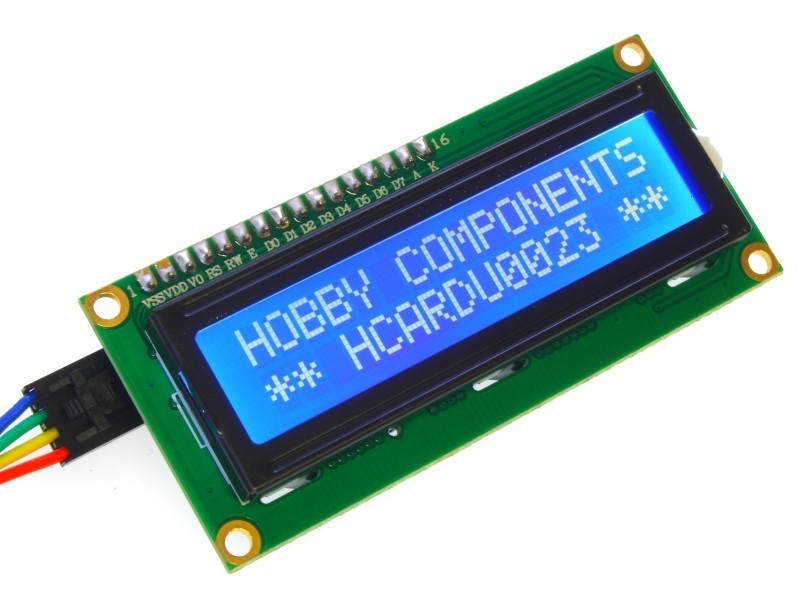0.9" 128 x 32 Serial I2C...
These tiny 0.9 inch uOLED displays have a resolution of 128 x 32 pixels and use a standard...
- On sale!






This 16 character by 2 line display has a very clear and high contrast white text upon a blue background/backlight. It also includes a serial I2C/IIC adaptor board pre-soldered to the back of the LCD....
This 16 character by 2 line display has a very clear and high contrast white text upon a blue background/backlight. It also includes a serial I2C/IIC adaptor board pre-soldered to the back of the LCD. This means it can be controlled with just 2 I2C serial data pins (SDA & SCL) and so requires far less digital IO pins when controlled from a microcontroller. In total the module only requires 4 wires including 5V power and GND. Contrast adjustment is also provided by the daughter board via a potentiometer. If you plan to use this with an Arduino board you can download a compatible library and example sketch from our support forum here.
Product Code HCARDU0023
Features 64mm x 14mm LCD display, supports IIC / I2C
Application DIY Arduino based project. Allows remote panel mounting. Requires only 2 IO pins.
Notes:
These modules are currently supplied with a default I2C address of either 0x27 or 0x3F. To determine which version you have check the black I2C adaptor board on the underside of the module. If there a 3 sets of pads labelled A0, A1, & A2 then the default address will be 0x3F. If there are no pads the default address will be 0x27.
The module has a contrast adjustment pot on the underside of the display. This may require adjusting for the screen to display text correctly.
If pressure is applied to the I2C daughter board it is possible for it to bend and come contact with the LCD module. Please ensure when the LCD is installed in your application that no external object is applying pressure to the back of the module.
Model |
YwRobot |
| Quantity | 1 |
| Features | 2.6" LCD display, supports IIC / I2C |
| Application | DIY Arduino based project. Allows remote panel mounting. Requires only 2 IO pins. |
| PINOUT | |
|---|---|
| PIN | DESCRIPTION |
| 1 | GND |
| 2 | VCC (+5V) |
| 3 | SDA |
| 4 | SCL |
Example code with library download can be found in our forum.
EXAMPLE CODE
ARD_LCD_HCARDU0023_SPI_Hello_World_Example.pde
/* FILE: ARD_LCD_HCARDU0023_I2C_Hello_World_Example.pde DATE: 07/09/12 VERSION: 0.1 This is a simple example of how to use the Hobby Components I2C LCD module (HCARDU0023). To use this module you will require the appropriate library which can be downloaded from the modules section of our support forum at the following location: http://forum.hobbycomponents.com This code also demonstrates the correct pin assignment for the LCD. When you run this program you should see a greeting message appear on the display. DEVICE PINOUT (SPI Interface): PIN 1: GND PIN 2: +5V PIN 3: SDA - Connect to Arduino analogue PIN 4 PIN 4: SCL - Connect to Arduino analogue PIN 5 You may copy, alter and reuse this code in any way you like but please leave reference to hobbycomponents.com in your comments if you redistribute this code. */ /* Include the SPI/IIC Library */ #include <Wire.h> #include <LiquidCrystal_I2C.h> /* Initialise the LiquidCrystal library. Note that the displays will have a default I2C address of either 0x27 or 0x3F. Uncomment one of the lines below depending on the address of your module. */ //LiquidCrystal_I2C lcd(0x27,20,4); LiquidCrystal_I2C lcd(0x3F,20,4); void setup() { /* Initialise the LCD */ lcd.begin(); } /* Main program loop */ void loop() { /* Make sure the backlight is turned on */ lcd.backlight(); /* Output the test message to the LCD */ lcd.setCursor(0,0); lcd.print("HOBBY COMPONENTS"); lcd.setCursor(0,1); lcd.print("**HELLO WORLD**"); /* Do nothing */ while(1); }
These tiny 0.9 inch uOLED displays have a resolution of 128 x 32 pixels and use a standard...
A break-out board for an integrated RGB LED module. The module has 3 separate LED's (Red,...
This 8 digit seven segment display module (HCMODU0095) uses a TM6138 controller allowing full...
These tiny 0.9 inch uOLED displays have a resolution of 128 x 32 pixels and use a standard...
This 45mm module contains a strip of 16 individually controllable RGB LEDs arranged in a...
This the larger version of our 16x4 LCD display. Its 24 character by 4 line display has a very...
A 3.2" colour TFT display module compatible with 3.3V microcontrollers such as the Arduino...
This 66mm module contains a strip of 24 individually controllable RGB LEDs arranged in a...
The 1602 SmartLCD module is a serially controlled 2 line by 16 character alphanumeric LCD...
This 66mm module contains a strip of 16 individually controllable RGB LEDs arranged in a...
This 8x8 dot matrix LED (red) module is ideally suited for use with various microcontrollers...
A 2.4" colour TFT display module compatible with 3.3V microcontrollers such as the Arduino...
These tiny 0.96 inch uOLED displays have a resolution of 128 x...